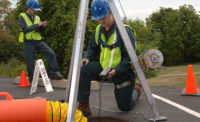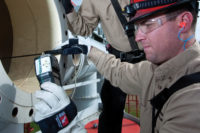Fatalities associated with confined space entry are most commonly the result of atmospheric circumstances, which are often difficult to immediately detect. Hydrogen sulfide and carbon monoxide are two of the most common poisonous gases found in such instances. In a NIOSH study of confined space entry fatalities from 1983-1993, 45 percent of deaths were caused by asphyxiation, or suffocation, due to an oxygen-deficient environment.
Although most deaths can be attributed to an oxygen-deficient or toxic environment, more than 60 percent of confined space fatalities occur among would-be rescuers. The scenario occurs repeatedly in multiple industries: The outside attendant monitoring the entry sees his co-worker in trouble and enters the space without taking the proper emergency rescue procedures to protect himself while saving his co-worker. The consequences are often fatal.
Ability to recognize
Proper training is necessary for workers to recognize: 1) what a confined space is, and 2) the hazards that may be encountered in the space. (OSHA defines a confined space in 29 CFR 1926.21.) The ability to recognize a confined space in conjunction with the proper testing, evaluation and monitoring of the atmosphere prior to entry can prevent an emergency situation. Developing proper rescue procedures is critical to keeping an emergency situation from turning to tragedy.
During the NIOSH study of confined space entry deaths from 1983-1989, only 27 percent of the employers had a written confined space entry procedure, and only 3 percent of the victims had received confined space entry training. Employers must know 1) what confined space hazards exist on their site, 2) when an entry is going to occur, and 3) what precautions must be made to ensure a safe entry. In the event of an emergency, employees must be able to complete a successful emergency rescue.
What’s in there?
Hazards associated with a confined space are dictated by the material stored or used in the confined space, the activity carried out in the confined space and the external environment surrounding the confined space. The most hazardous type of confined space is one that combines limited access and mechanical devices. All the hazards of open top and limited access confined spaces may be present together with the additional hazard of moving parts. Boilers are a common example of a confined space that usually contains mechanical devices.Hazardous atmospheres encountered in confined spaces can be divided into four distinct categories: flammable, toxic, irritant and/or corrosive, and asphyxiating. Each of your confined space workers should be properly trained on the components and causes of each atmosphere.
Toxins, poisonous gases, and irritants may not be detectable without monitoring the air quality. Before an employee enters the space, the internal atmosphere needs to be tested, with a calibrated direct-reading instrument, for oxygen content, flammable gases and vapors, and potential toxic air contaminants, in that order.
To the rescue
Rescue procedures must be established before entry and should be specific to the job at hand. A standby person should be present and have the proper rescue equipment. Rescue procedures should be practiced frequently.Training all employees on the hazards of confined spaces will help them recognize what a confined space is and the best safety practices to make each confined space entry injury- and incident-free.

